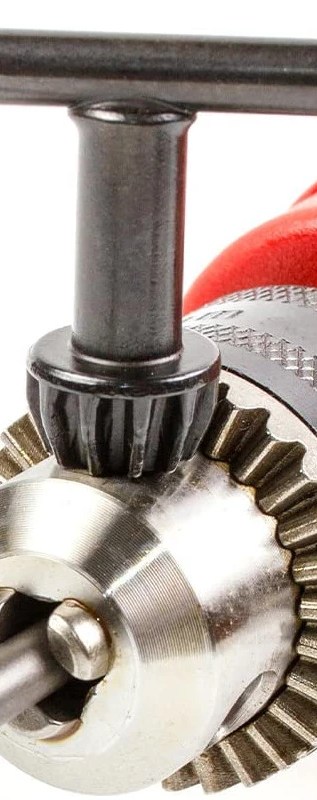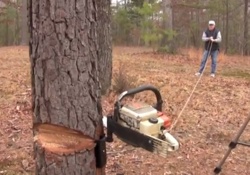What is a Chuck on a Drill –
A drill chuck is a spindle mounted device on a drill that can clamp drill bits and attachments for the main purpose of drilling holes or fixing screws. They are either keyless, operated with a drill chuck key or use a hybrid system. A drill cannot be used effectively unless it has a working chuck.
The vast majority of drills or drill/drivers use what is called a single sleeve chuck. Heavy duty hammer drills tend to use keyed chucks, where the chuck is tightened and loosened by using a “chuck key.”
Types of Drill Chuck Explained
There are six types of drill chucks:
- A Keyed Chuck
- A Single Sleeve Keyless Chuck
- A Double Sleeve Keyless Chuck
- An SDS Chuck
- Hex Connection Chuck
- Hybrid Chucks
1. Keyed Chucks
These are primarily used in corded drills, drill presses and for heavy duty drilling such as in a hammer drill. Slippage can be a big issue during heavy-duty operations. Keyed chucks have the benefit of delivering additional torque to the bit. Very few cordless drills will have a keyed chuck.
The jaws of a keyed chuck are loosened or tightened using a chuck key. When you insert a drill bit, this key is inserted into the chuck and turned clockwise to tigheten, or anti-clockwise to loosen the chuck. This allows the user to control how tight the chuck is closed and stops bits from slipping.
The disadvantage of this chuck is that it is easy to lose the key. It is really important to know that the chuck key must match exactly the chuck. There is no standard issue of chuck key that works across all manufacturers. Using the wrong key could strip the chuck rendering your drill useless.

2. Single Sleeve Keyless Chuck
This is the easiest chuck to use and also the most convenient. It can be operated using only one hand, leaving your other hand free to hold the bit or accessory. This is the type of chuck that you will find on most cordless drills and drill/drivers. It typically consists of three or four jaws that are tightened or loosened by rotating the outside sleeve.
They offer improved durability and reliability compared to traditional keyed chucks. That is because they have less wear on the moving parts.
3. Double Sleeve Keyless Chuck
For this type of keyless chuck you will need both hands. One hand will hold one part of the chuck, and your other hand is used to turn the chuck to loosen it or tighten it. It has two sleeves, an inner sleeve and an outer sleeve, which are tightened against each other to secure a drill bit or other tool in place.
The inner sleeve is the main part of the chuck and has a number of different sized teeth that grip the drill bit or other tool. The outer sleeve is the part that is turned to tighten or loosen the chuck.
4. An SDS Chuck
This is an exclusive chuck system only available on SDS drills and will only work with SDS drill bits. They are very easy to use. However, if you want to drill wood, metal or plastic with regular drill bits then you will also need an SDS+ adapter.
An SDS chuck (or “slotted drive system” chuck) is a type of drill chuck that uses specially designed drill bits with a tapered, slotted shank. It is designed to securely hold these bits in place during drilling and hammer drilling applications. This type of chuck is commonly used with rotary hammer drills.
5. Hex Connection Chuck
This type of chuck is used on cordless impact drivers. These chucks work by pulling the chuck forwards, placing the drill bit in and then releasing the chuck. You use the same process to remove the drill bit. It is a very effective and easy to use system.
A hex connection chuck is a type of chuck used to securely hold the shank of a drill bit. These are also used in a rotary tool such as a drill press or a hand drill. It is designed with a hexagonal shape that allows the drill bit to fit tightly into the chuck, preventing it from slipping or becoming loose during use.
6. Hybrid Chucks
Keyed and keyless options are available in hybrid drill chucks. The keyless section tightens automatically, while the keyed portion is adjusted on the chuck for increased gripping and torque support. These are really only available for machine type drilling.
A hybrid chuck is a combination of a drill chuck and a collet chuck. It offers the benefits of both types of chucks by combining their features, allowing for quick and secure tool clamping. It is used to hold a variety of tools such as drill bits, reamers, tapping tools and end mills.
Drill Chuck Sizes
The maximum size of a drill or screwdriver bit that can be inserted into a drill is absolutely determined by the chuck size. The size of the chuck required will frequently be determined by the function for which it will be used. The size of the chuck determines the drill’s maximum drill bit diameter.
The shank diameter of a bit is the measurement across the centre of the shank. Hexagonal shanks are measured across their flats. The measurement for a round shank’s diameter can be taken from any point around the circumference.
Drill chucks come in two main standard sizes:
- 10mm (3/8″)
- 13mm (1/2″)
For most general types of drilling the 10mm chuck is a good choice. For heavier drilling, or if you need to drill larger holes, it is better to get a drill with a 13mm chuck as that allows you to cater for thicker diameter drill bits.
How does a Drill Chuck Work?
There are several parts to drill chucks. These include:
- Sleeve – this rotates around the body and will turn the ring nut
- Gear teeth – interlocks with the jaw’s teeth
- Body – the purpose of this is to position the jaw’s movement
- Jaws – these are what clamps the accessories
- Outside Shell – this holds the moving parts
- Some may also have a key and ring nut – the ring nut turns and the teeth interlock with the jaw’s teeth
The arbor is a tapered shaft that fits into the spindle of the power drill. The jaws are spring-loaded and fit around the arbor. The key or chuck key is used to tighten or loosen the jaws so that the drill bit can be secured in place. When the chuck key is turned, the jaws move inward or outward to grip the drill bit. When the drill is turned on, the arbor rotates and the jaws hold the drill bit firmly in place, allowing for precise and accurate drilling.
With keyless chucks no key is used and the chuck is simply tightened by hand.
Common Problems with Drill Chucks
Wear and Tear
Usually the main problem is simply wear and tear. The teeth wear over time and the jaws weaken over time. That means the chuck can’t hold bits properly and it will start to slip. Teeth also wear out on the chuck and it starts to stick. They are difficult to repair and it is better to replace the chuck.
Drill bits slipping
If you start to notice your drill bits slipping this is because the chuck is not tight enough. With a keyed chuck you simply need to tighten the chuck some more. With keyless chucks you can try to tighten by hand. If that doesn’t work then it is likely the chuck is reaching the end of life and will need to be replaced.
Dirt and dust
Over time chucks can get dirty from a mixture of dust and/or fragmented pieces of material. It is always worthwhile using a small brush to try and clean out any dust or debris in the chuck. It is limited in how much you can do but it is always a good maintenance job to do every now and then.
How to Install a Drill Chuck?
You will need to get a replacement chuck from the brand for your exact brand and model of drill. If you can do that, it will be cheaper than buying a replacement drill. Good drill brands always have chucks available as spare parts. You may also be able to find chuck replacements on auction sites such as eBay.
Before removing the old chuck, make sure it is not plugged in. If it is a cordless drill then disconnect the drill’s battery pack. Most chucks have a threaded spindle chuck. Open the jaws as far as you can and remove the left-hand thread screw if there is one.
You can then attach a hex-type wrench into the chuck’s body and tighten it up. Using a mallet, hit the wrench counterclockwise and unscrew the chuck. You can then attach the new chuck, tighten the jaws with the wrench and hit the wrench again with the mallet to tighten it fully.
For tapered shank arbors, open the jaws until they are retracted into the chuck and place the chuck nose inside. Rest it on a flat surface and hit the tang of the arbor lightly to seal this into the new chuck.
What Is A Cordless Drill Used For In UK
@media (min-width: 300px){[data-css=”tve-u-188526f7e6f”].tcb-post-list #post-2671 [data-css=”tve-u-188526f7e72″]{background-image: url(“https://i0.wp.com/uktoolguide.com/wp-content/uploads/2023/11/How-To-Clean-And-Maintain-A-Cordless-Drill-UK.webp?fit=600%2C420&ssl=1”) !important;}}
How To Clean And Maintain A Cordless Drill UK
@media (min-width: 300px){[data-css=”tve-u-188526f7e6f”].tcb-post-list #post-2674 [data-css=”tve-u-188526f7e72″]{background-image: url(“https://i0.wp.com/uktoolguide.com/wp-content/uploads/2023/11/storage-rack-for-a-cordless-drill.webp?fit=955%2C1024&ssl=1”) !important;}}
How To Store A Cordless Drill Properly UK
@media (min-width: 300px){[data-css=”tve-u-188526f7e6f”].tcb-post-list #post-2677 [data-css=”tve-u-188526f7e72″]{background-image: url(“https://i0.wp.com/uktoolguide.com/wp-content/uploads/2023/11/Where-To-Buy-Cordless-Drills-In-The-UK.webp?fit=500%2C500&ssl=1”) !important;}}
Where To Buy Cordless Drills In The UK
@media (min-width: 300px){[data-css=”tve-u-188526f7e6f”].tcb-post-list #post-1940 [data-css=”tve-u-188526f7e72″]{background-image: url(“https://i0.wp.com/uktoolguide.com/wp-content/uploads/2023/05/best-cordless-drill-under-50.webp?fit=640%2C400&ssl=1”) !important;}}
Best Cordless Drill Under £50 UK
@media (min-width: 300px){[data-css=”tve-u-188526f7e6f”].tcb-post-list #post-1791 [data-css=”tve-u-188526f7e72″]{background-image: url(“https://i0.wp.com/uktoolguide.com/wp-content/uploads/2023/05/How-to-Drill-Holes-for-Electrical-Wires.webp?fit=640%2C400&ssl=1”) !important;}}
How to Drill Holes for Electrical Wires

